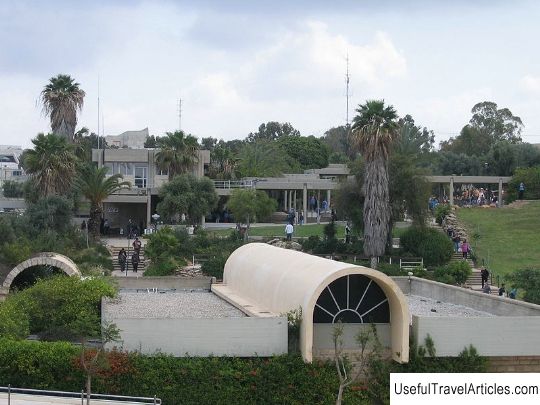Eretz Israel Museum description and photos - Israel: Tel Aviv
Rating: 8,1/10 (232 votes) 
Eretz Israel Museum description and photos - Israel: Tel Aviv. Detailed information about the attraction. Description, photographs and a map showing the nearest significant objects. The title in English is Eretz Israel Museum. Photo and descriptionThe Historical and Archaeological Museum of Eretz Israel (the land of Israel) is located in the Ramat Aviv region. Its exhibition pavilions contain exhibits telling about millennia of the Israeli land. The museum was founded in 1953, just five years after the formation of the State of Israel. Its pavilions are located in the garden, each dedicated to a different topic: ceramics, coins, copper products, glass. In a special pavilion, ancient methods of weaving, baking, jewelry and pottery are demonstrated. But the main thing here is a huge number of archaeological exhibits, some of which are unique. The emergence of the museum is associated with the name of the elder of Israeli archaeologists Benjamin Mazar, who began searching for antiquities hidden in the Holy Land in 1932. It was he who, the first newly created Jewish state, allowed in 1948 to begin excavations in Tel Kasil on the banks of the Yarkon River. Back in 1815, the socialite and traveler Lady Esther Lucy Stanhope claimed that there was an ancient settlement in this place. The lady was not wrong. Benjamin Mazar discovered the ruins of a 12th century BC Philistine city. Now, in a pit on the territory of the museum, you can see artifacts of twelve different cultural layers, up to the Islamic era. Here are the remains of the walls of three ancient temples, built one on top of the other. The walls are made of sun-dried bricks covered with light plaster; inside, along the walls, there are low benches. The adjacent residential buildings are built according to a single standard, their area is about 100 square meters, each has two rooms and a patio. The exhibits provide an opportunity to get acquainted with the course of one of the first technological revolutions in human history, marked by the development of copper. The Eneolithic (the era of transition from the Stone Age to the Copper Age) dates back to the 4th millennium BC. This is the age of the primitive melting furnace on display in the museum. Better domed furnaces date back to the XIII-XIV centuries BC. At that time, the Egyptians smelted copper on the territory of present-day Israel, and many copper figurines and cartouches remained from them. Of particular interest is a copper serpent with a gilded head - a similar one is mentioned in the Old Testament, in the Book of Numbers. When the Jews of the Exodus began to suffer from poisonous snakes, Moses, at the direction of God, raised a copper serpent, at the sight of which the bitten one remained alive. Over time, the children of Israel began to worship this idol, giving it the name Nehushtan, and then King Hezekiah “destroyed the brazen serpent” (2 Kings 18: 4). The pavilion dedicated to the Copper Age is called “Nehushtan”. The museum has one of the largest numismatic collections in Israel: coins from the 6th century BC are presented here. The pavilion dedicated to crafts displays tools of all ages: flint knives, mills, a loom, tools for woodworking. The collection of the glass pavilion begins with items from the Late Bronze Age. Funny Roman glass perfume bottles, very similar to modern ones.       We also recommend reading Monument to soldiers-drivers description and photo - Russia - Volga region: Saratov Topic: Eretz Israel Museum description and photos - Israel: Tel Aviv. |




